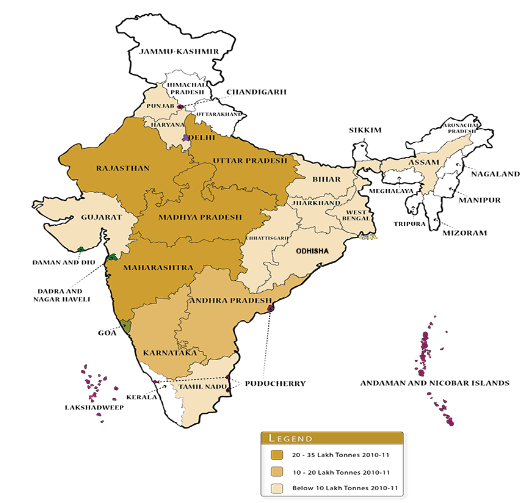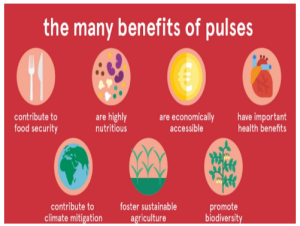Context:
- As demand for arhar (pigeon peas) in India continues to outpace domestic production, farmers in Australia and Brazil plan to grow the popular yellow lentil for Indian consumers.
| Probable Question:
Q. What are the key challenges hindering pulse production in India, and suggest strategies that can be implemented to overcome these challenges and enhance pulse production in the country. |
About Pulses:
- Pulses are annual leguminous crops or seeds of variable size, shape and colour used for both food and feed.
- The term “pulses” only applies to crops that are grown for their dry grain. This means that green crops grown for food, which are called vegetable crops, as well as crops grown mostly for oil extraction and leguminous crops grown only for sowing, are not included.
Status in India:
- India’s Ranking: India is the largest producer (25% of global production), consumer (27% of world consumption) and importer (14%) of pulses in the world.
- Area: Pulses account for around 20 percent of the area under food grains and contribute around 7-10 per cent of the total foodgrains production in the country. Productivity of pulses is 764 kg/ha.
- Growing season: Though pulses are grown in both Kharif and Rabi seasons, Rabi pulses contribute more than 60 per cent of the total production.
- Dominant pulse: Gram is the most dominant pulse having a share of around 40 per cent in the total production followed by Tur/Arhar at 15 to 20 per cent and Urad/Black Matpe and Moong at around 8-10 per cent each.
- States Ranking: Madhya Pradesh, Maharashtra, Rajasthan, Uttar Pradesh and Karnataka are the top five pulses producing States.
- Major Export Destinations (2022-23) : Bangladesh, China, UAE, U.S.A and Nepal.

Major pulses grown and consumed in India:
- Bengal Gram (Desi Chick Pea / Desi Chana)
- Pigeon Peas (Arhar / Toor / Red Gram)
- Green Beans (Moong Beans)
- Chick Peas (Kabuli Chana)
- Black Matpe (Urad / Mah / Black Gram)
- Red Kidney Beans (Rajma)
- Black Eyed Peas (Lobiya)
- Lentils (Masoor)
- White Peas (Matar)
Tur and Urad statistics:
- Tur: Tur occupies 33 per cent of pulses area and contributes to 48 per cent of total kharif pulses production. Of this, the top 3 States — Maharashtra, Karnataka and Madhya Pradesh — contribute 64 per cent to area and production.
- Urad: Urad has 28 per cent share in area and 23 per cent in kharif pulse production. The top three states —Madhya Pradesh, Rajasthan and Uttar Pradesh — contribute about 73 per cent to area and 69 per cent to production of urad
Unique role of pulses:
- Environmentally sustainable: Pulses grow on a wide range of soil and climatic conditions. They are better suited in different farming systems, such as crop rotation, mixed and inter-cropping systems.

- Nitrogen Fixation: Legumes help to fix atmospheric nitrogen into the soil and release soil-bound phosphorus. They add organic matter into the soil in the form of leaf mold. Some pulses are suitable as green-manure crops.
- Checking soil erosion: They help check the soil-erosion,contributing to maintaining soil fertility level.
- Raw material for industries: Pulses as industrial crops provide raw material to industries, such as dal industry, roasted grain industry, papad industry, etc.
- Nutritious Cattle feed: They serve as a rich source of nutritious fodder for cattle.
- Low carbon footprint: Pulses have low carbon emission and water needs which make them ideally suited in India’s farming system. As per recent estimates, water needs for the production of one kg meat are five times higher than that of pulses.
Challenges with pulse production in India:
- Per capita availability: Per capita net availability of pulses in India, has reduced from 51.1 gm/day (1971) to 41.9 gm/day (2013) as against WHO recommendation of 80gm/day. This raises questions about the nutritional aspect as pulses are considered to be ‘poor man’s protein’.
- Ineffectiveness of MSP: NAFED and SFAC are responsible to procure pulses under MSP but they have been procuring an insignificant quantity of pulse. Thus, pulse-growers are often receiving prices much below MSP
- Open import policy: Pulses are imported at prices lower than the domestic ones, leading to poor price discovery for domestic farmers.
- Inefficient marketing arrangement: The absence of efficient marketing arrangement and production constraints created a huge gap between demand and supply resorting to imports. There is a deficit of about 17 lakh tonnes in Indian demand and supply
- Lack of assured irrigation: Between 1966-67 and 2012-13, the area under irrigation increased from 38% to 59% for rice and 48% to 93% for wheat as against 9 %to 16% for pulses. Around 84% area under pulses is rain-fed with soils relatively of low fertility
- Climate change: Climate drought and heat stress influence 50% reduction in seed yields particularly in arid and semi-arid regions of the country.
- Soil salinity and alkalinity: Soils growing pulses have a high level of salinity and alkalinity in semi-arid tropics and Indo-Gangetic plains
- Poor Drainage system: poor drainage leading to waterlogging during the rainy season in States of UP, Bihar, West Bengal, Chhattisgarh, MP and Jharkhand causes substantial yield losses in pigeon-pea in particular
- Green revolution: Farmers conventionally used their own saved seeds and practically used no phosphatic fertilizers. The green revolution pushed pulses cultivation in marginal and sub-marginal lands resulting in declining productivity
- Pests and diseases: Pulses being rich in nitrogen and phosphorus content are easy victims of insects, pests and diseases which severely reduce the productivity of chickpea, pigeon pea and lentil.
- Institutional credit: Inability of small, marginal and tenant farmers to access institutional credit discourage them to purchase and use seeds of high-yielding varieties, phosphatic fertilizers and adopt improved technology.
Way Forward:
- Effective MSP: India’s dependence on imported pulses is likely to continue in the near future too but to ensure domestic farmers do not lose, governments need to ensure that the landed cost of imported pulses does not fall below MSPs.
- Revision of MSP formula: The MSP formula should be revised and the purchase of each crop in the entire country should be ensured at that declared price.
- Efficient forecasting: Significantly improving India’s capacity to forecast nearer to correct estimates of area under pulses and output of pulses through better use of technology and methods in the 21st century.
- Timely availability of inputs: Putting all-out efforts to transfer the proven and demonstrated technologies at farmers’ fields accompanied by an efficient system of linking institutional credit with on-time availability of quality inputs and marketing services that can guarantee expected yield.
- Buffer stock: Building a need-based buffer stock with accountability for proper management incurring no wastage.
- Enforcement of ECA: A better system of easy availability of pulses in the open market throughout the year through efficient and rigorous enforcement of essential commodities Act(ECA) and need-based/warranted distribution through PDS if necessary or direct benefit transfer scheme.
- Harnessing market potential: The potential of markets should be harnessed through value chain approach right from the production at farm level and encompassing post-harvest, processing, packaging, transportation] to marketing for small and marginal farmers to reduce losses/wastages and increase income.
- Reducing import dependency: The dependence on import of pulses needs to be reduced gradually over time by stepping up the domestic production of pulses supported with appropriate long-term strategies.
News Source: Business Standard
![]() 15 Jul 2023
15 Jul 2023


